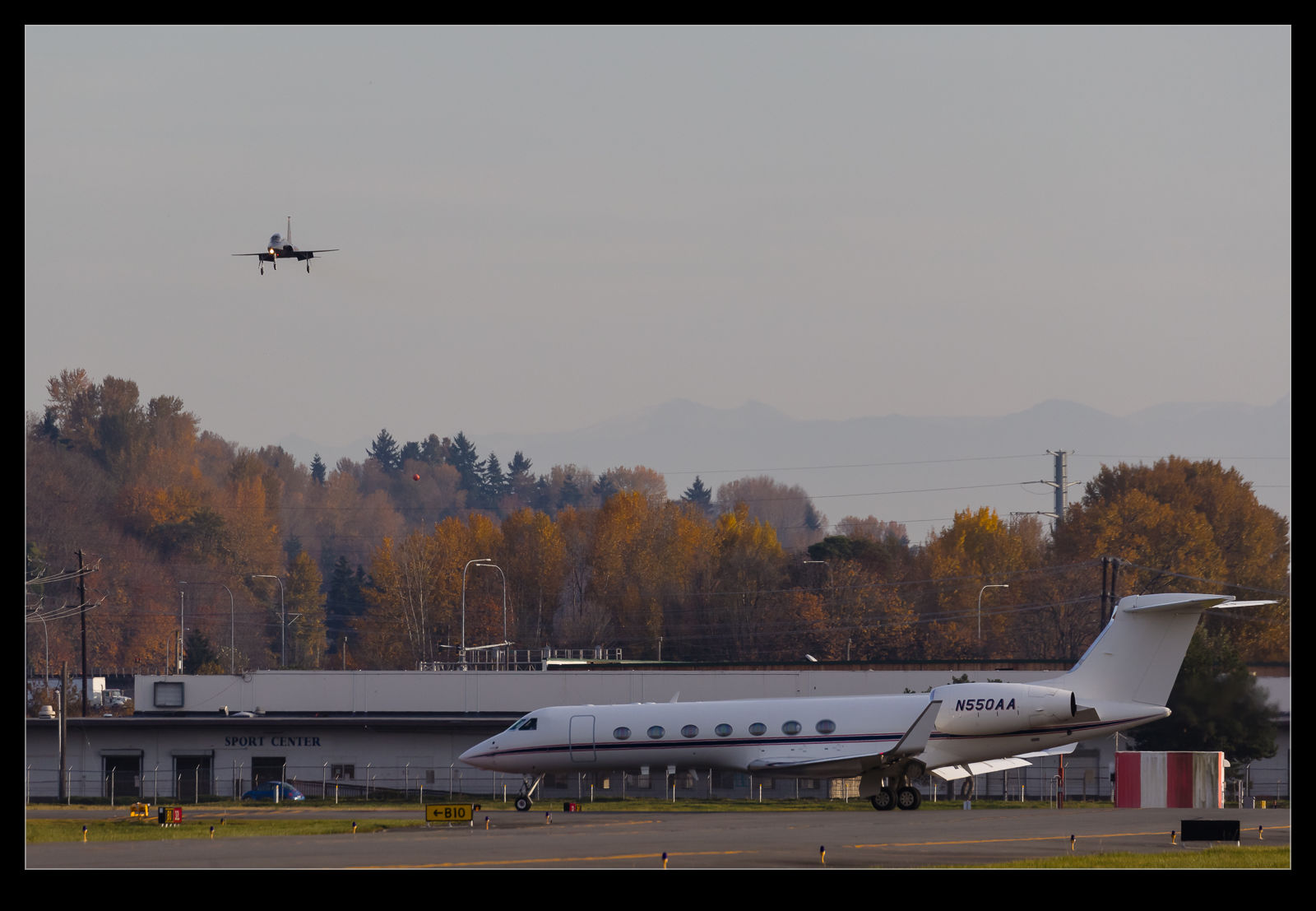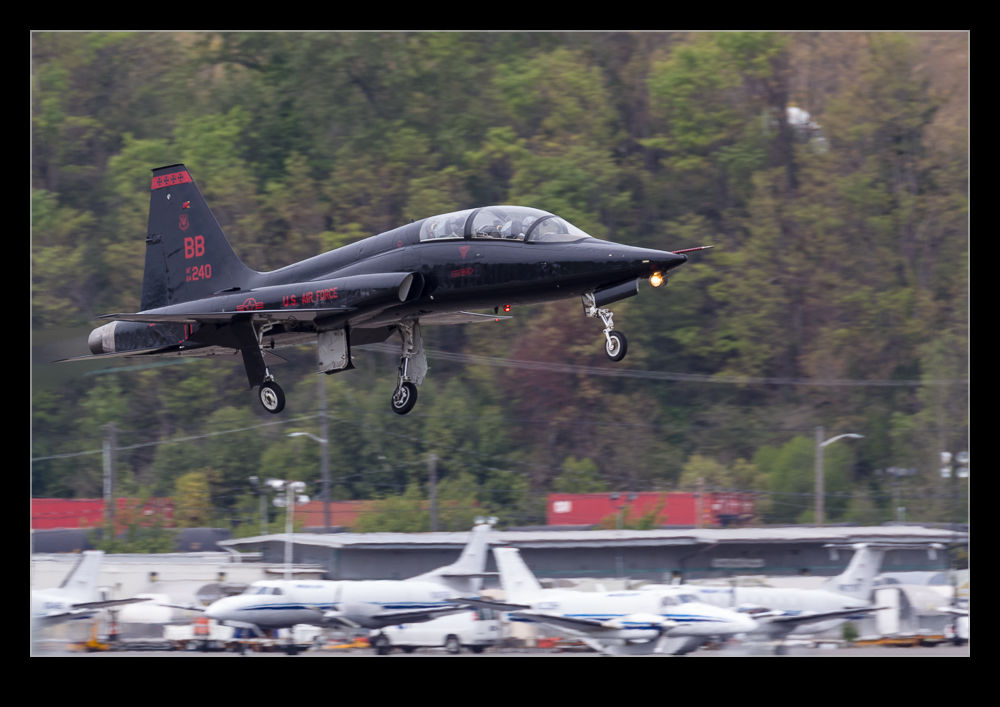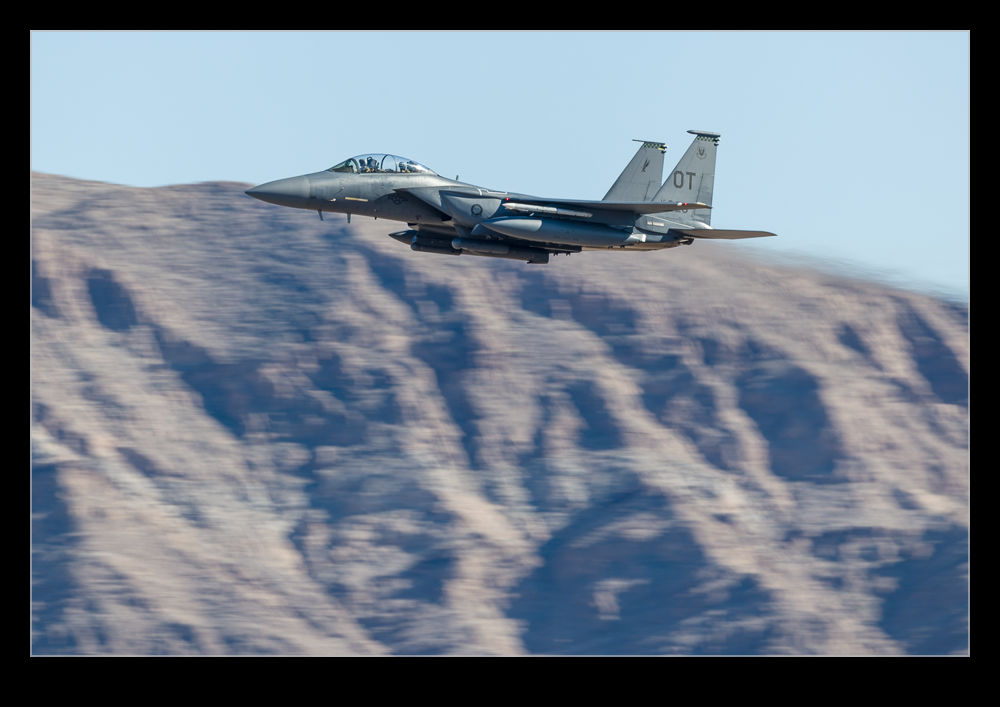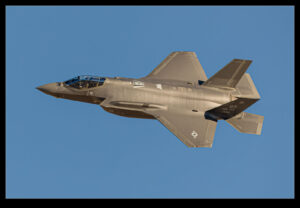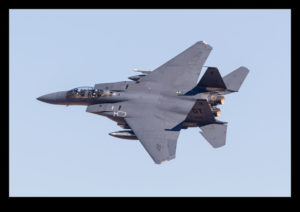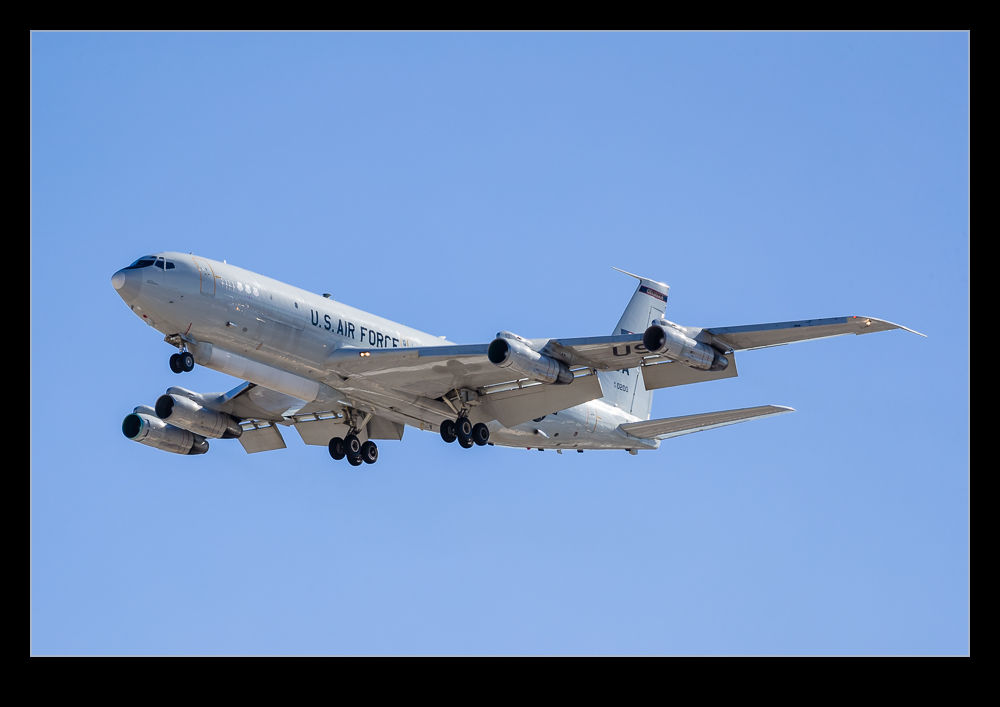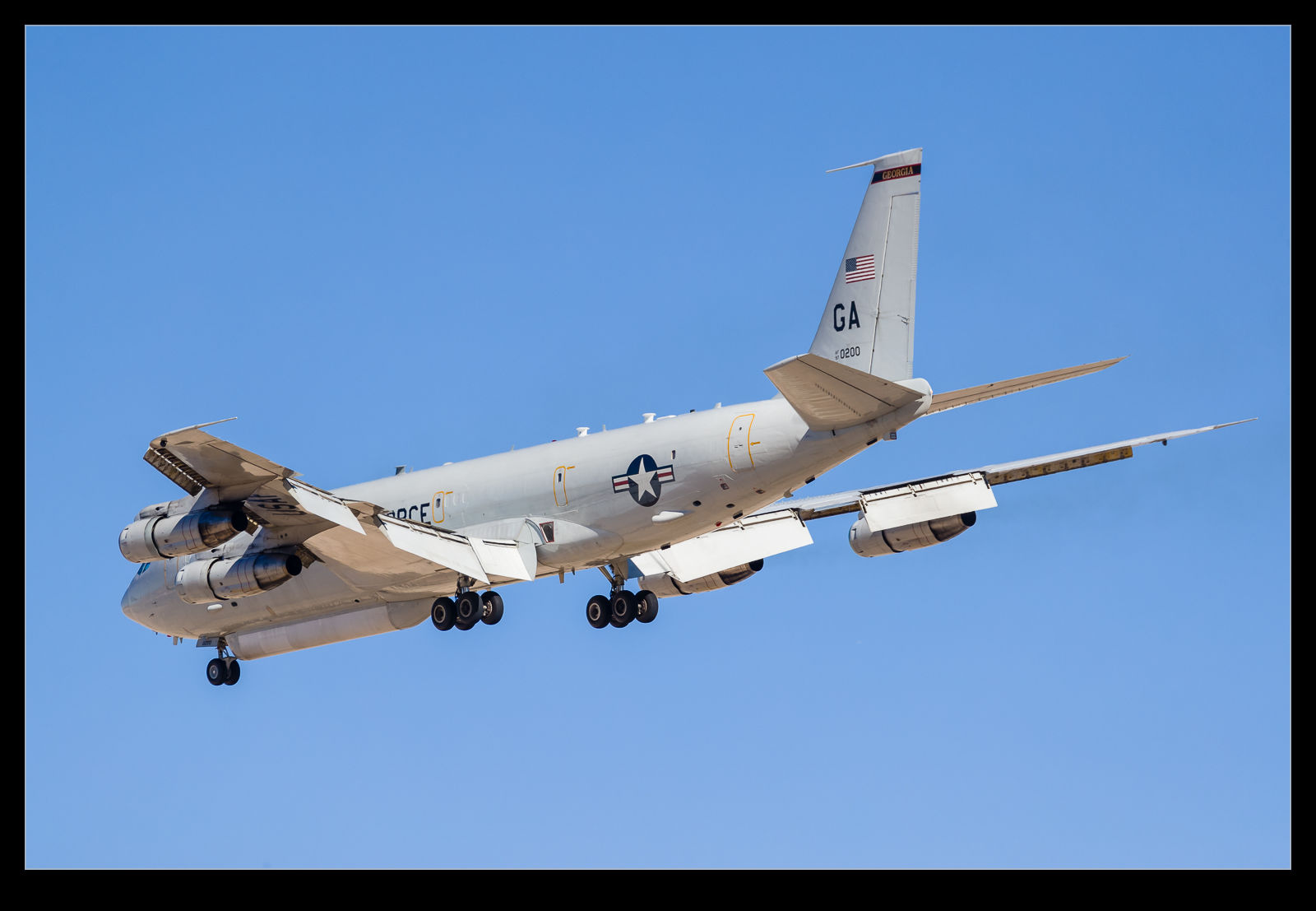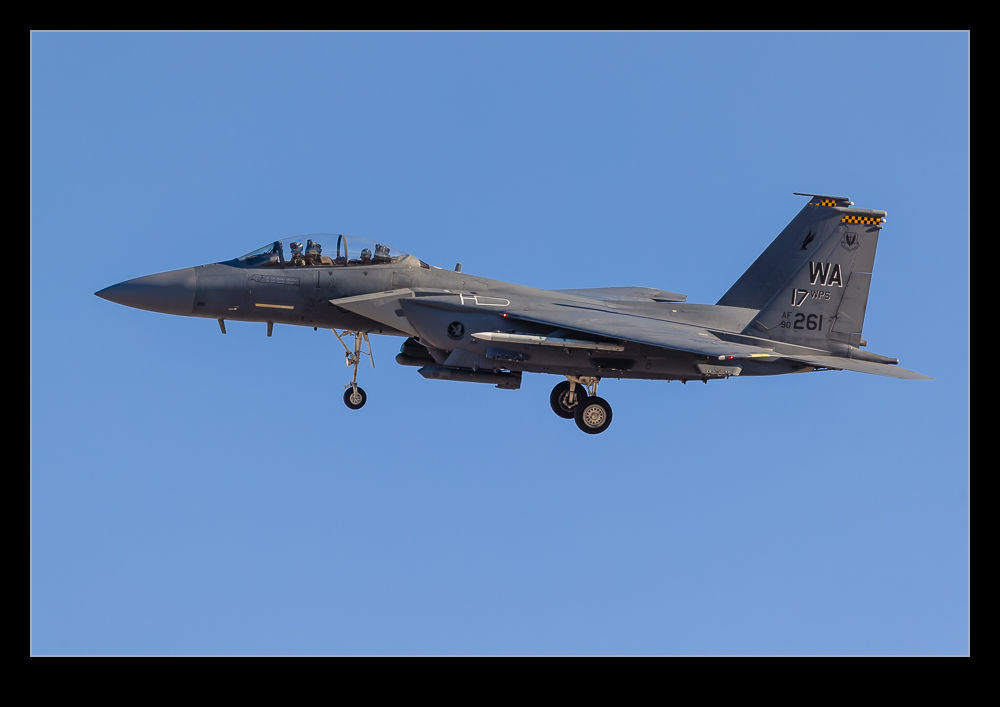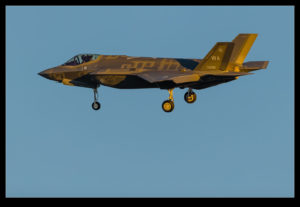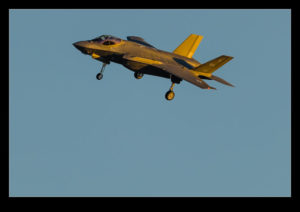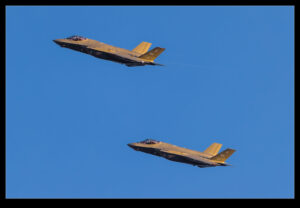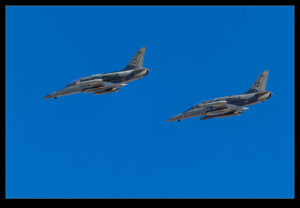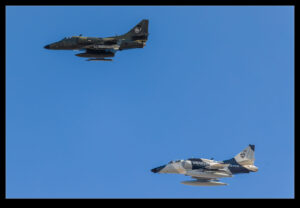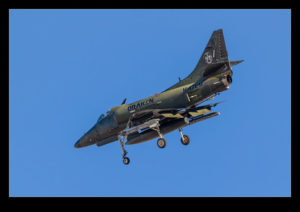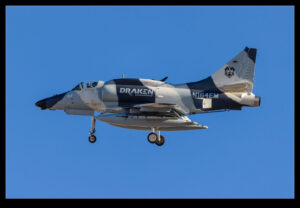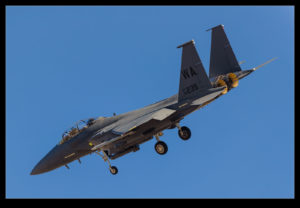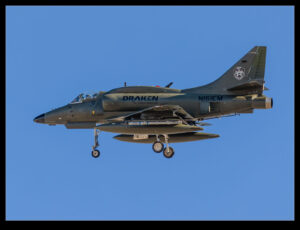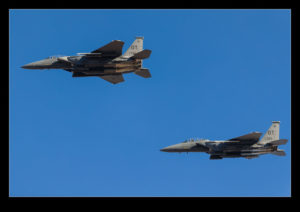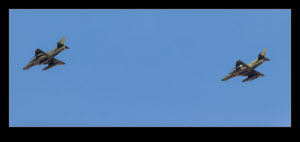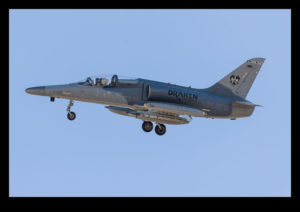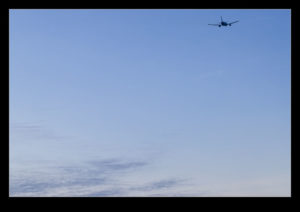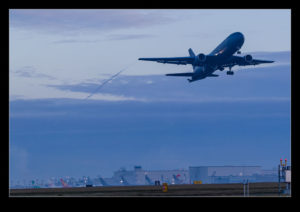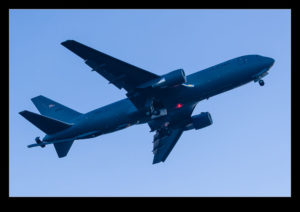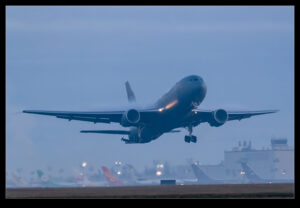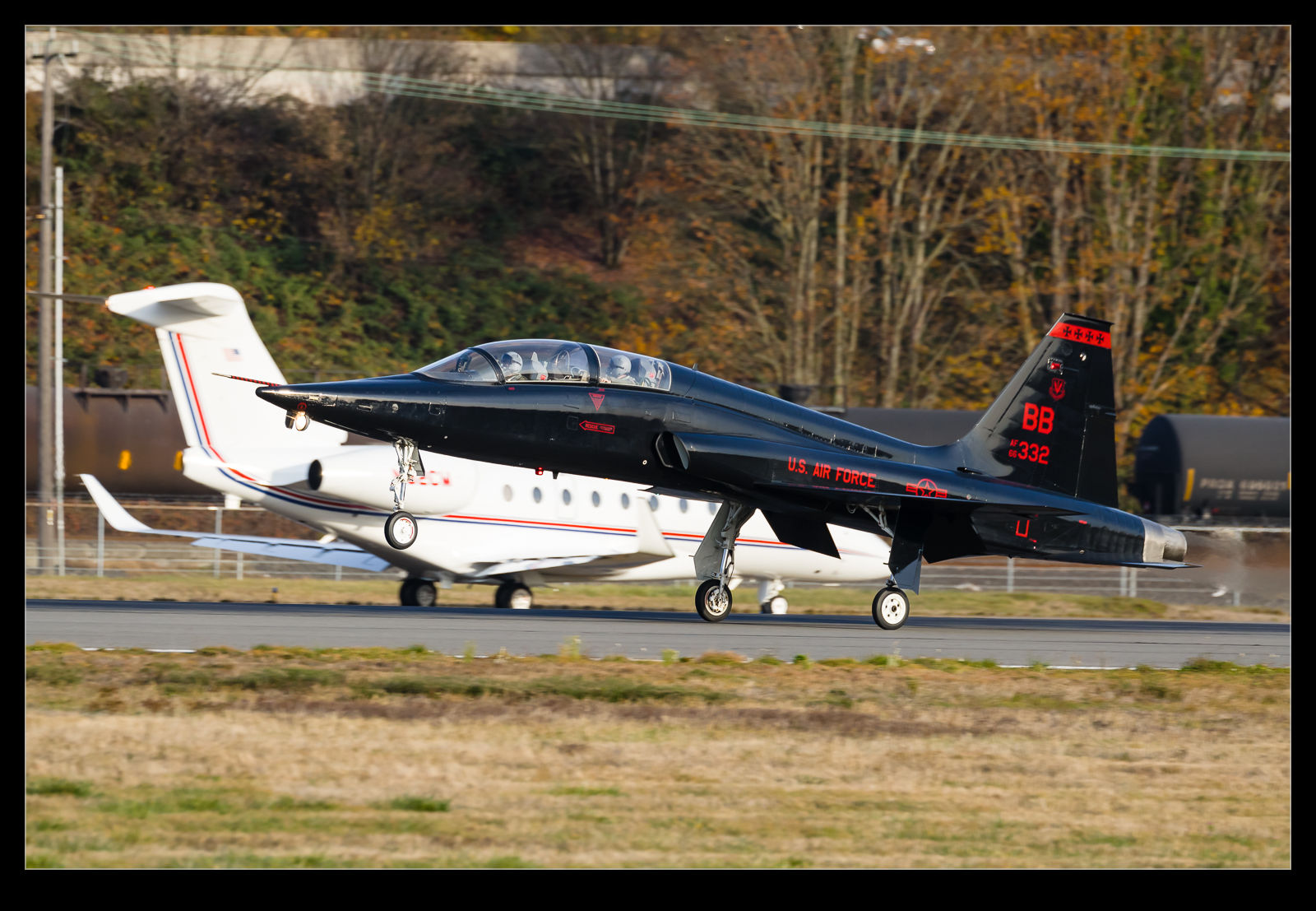 Boeing Field gets the occasional military visitors and you never know what might show up. I glanced up and saw a pair of T-38s downwind for arrival. They came in with about a minute of spacing between them. The tail codes showed them to be Beale jets. They headed to the FBO at Modern and were soon being refueled. The canopies stayed up so they may have been heading out again a while later but I had to move on so I didn’t get to see them depart.
Boeing Field gets the occasional military visitors and you never know what might show up. I glanced up and saw a pair of T-38s downwind for arrival. They came in with about a minute of spacing between them. The tail codes showed them to be Beale jets. They headed to the FBO at Modern and were soon being refueled. The canopies stayed up so they may have been heading out again a while later but I had to move on so I didn’t get to see them depart.
Tag Archives: USAF
Nice T-38 Surprise
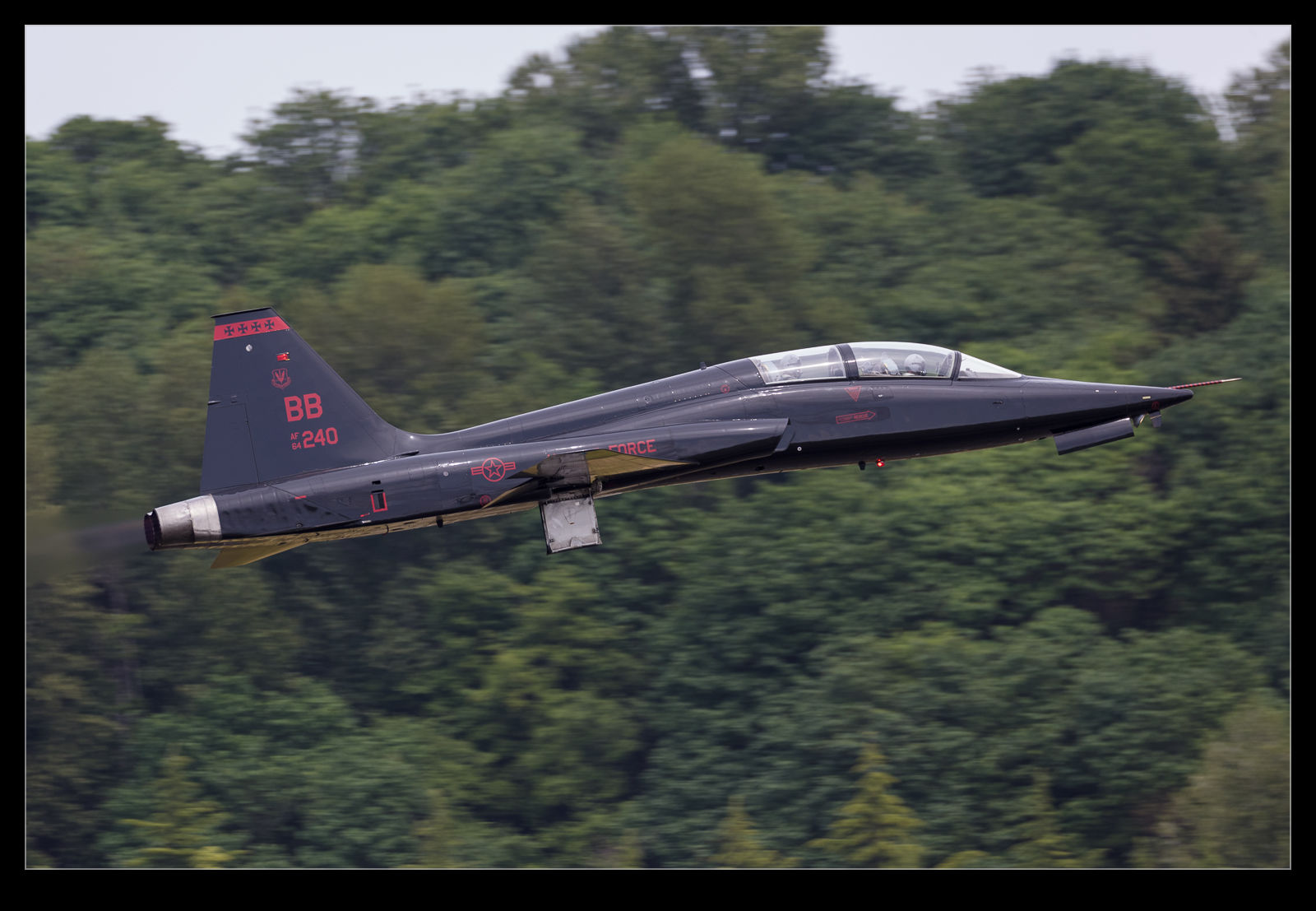 A Beale AFB T-38 was parked over at the FBO when I was at Boeing Field. The canopies were up which gave me optimism but you never know whether they are just doing something to the jet or maybe haven’t long arrived. When the crew walked out to the jet, I realized it was good news. They taxied to the other end of the field and I waited. A nice low departure kept them below the skyline of the hill beyond the field and I was happy with a slightly unusual visitor being photographed.
A Beale AFB T-38 was parked over at the FBO when I was at Boeing Field. The canopies were up which gave me optimism but you never know whether they are just doing something to the jet or maybe haven’t long arrived. When the crew walked out to the jet, I realized it was good news. They taxied to the other end of the field and I waited. A nice low departure kept them below the skyline of the hill beyond the field and I was happy with a slightly unusual visitor being photographed.
Tankers at Sunrise
 Boeing started delivering KC-46s to the USAF as I covered in this post. However, it didn’t take too long before the Air Force found various items of tooling in the aircraft that shouldn’t have been there and stopped taking delivery. Consequently, rather than delivering the backlog, it has continued to build. Paine Field had well over a dozen aircraft in various locations when we were there including three over by the Heritage Flight Foundation’s hangars. Here three were illuminated nicely by the sun as it rose across the field so a pano seemed in order.
Boeing started delivering KC-46s to the USAF as I covered in this post. However, it didn’t take too long before the Air Force found various items of tooling in the aircraft that shouldn’t have been there and stopped taking delivery. Consequently, rather than delivering the backlog, it has continued to build. Paine Field had well over a dozen aircraft in various locations when we were there including three over by the Heritage Flight Foundation’s hangars. Here three were illuminated nicely by the sun as it rose across the field so a pano seemed in order.
Low and Sporty Lightning II Departure
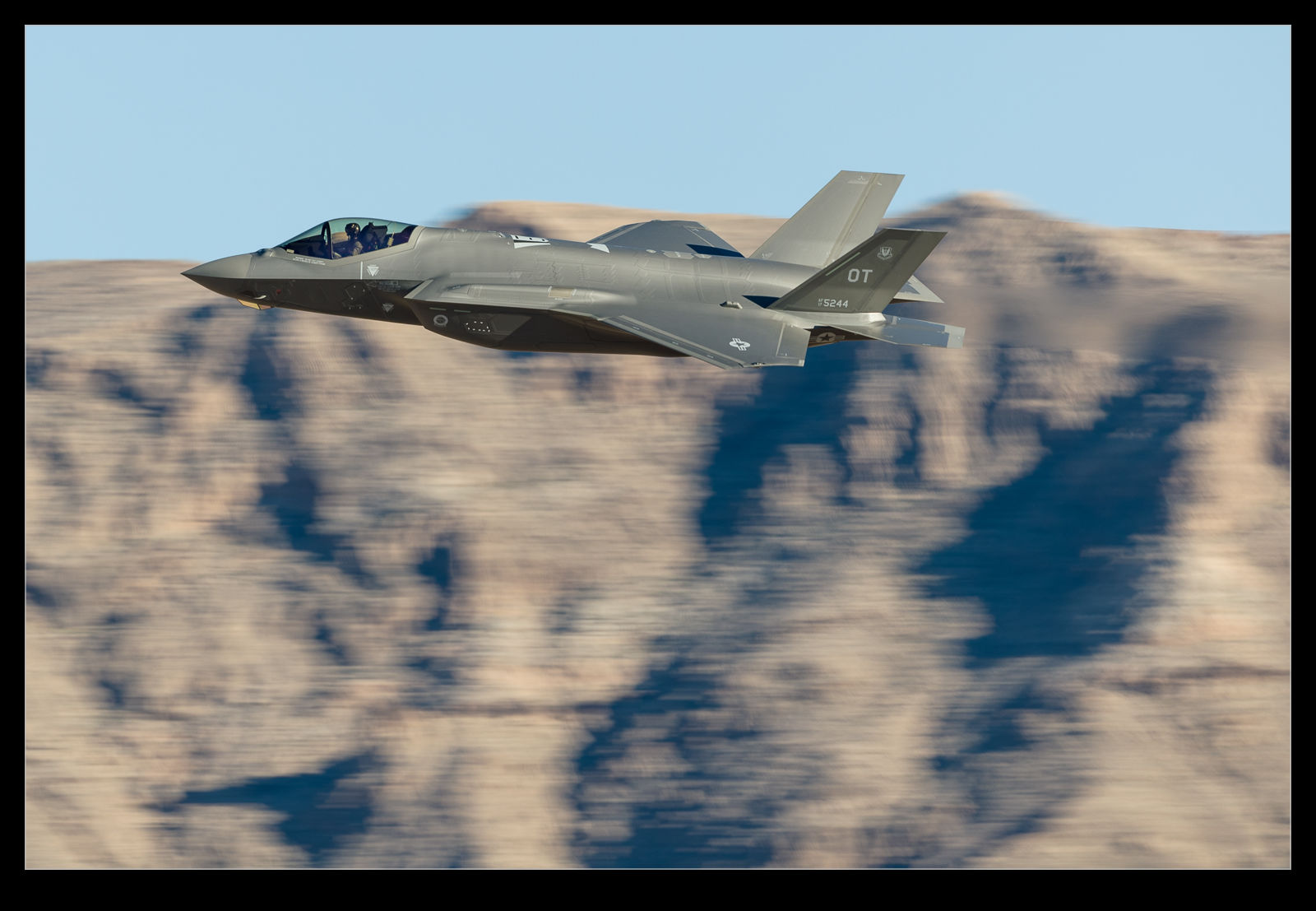 Speedway departures can be a mixed bag at Nellis. Flex departures with a pull over the Speedway are the best but it does depend on how high planes have got. Some climb out quite steeply and are way too high for a good shot by the time that they reach you. On my most recent Nellis trip, though, we were treated to a few departures by the locals that broke the mold. They got airborne and kept it nice and low as they accelerated towards us before breaking in to the flex departure routing.
Speedway departures can be a mixed bag at Nellis. Flex departures with a pull over the Speedway are the best but it does depend on how high planes have got. Some climb out quite steeply and are way too high for a good shot by the time that they reach you. On my most recent Nellis trip, though, we were treated to a few departures by the locals that broke the mold. They got airborne and kept it nice and low as they accelerated towards us before breaking in to the flex departure routing.
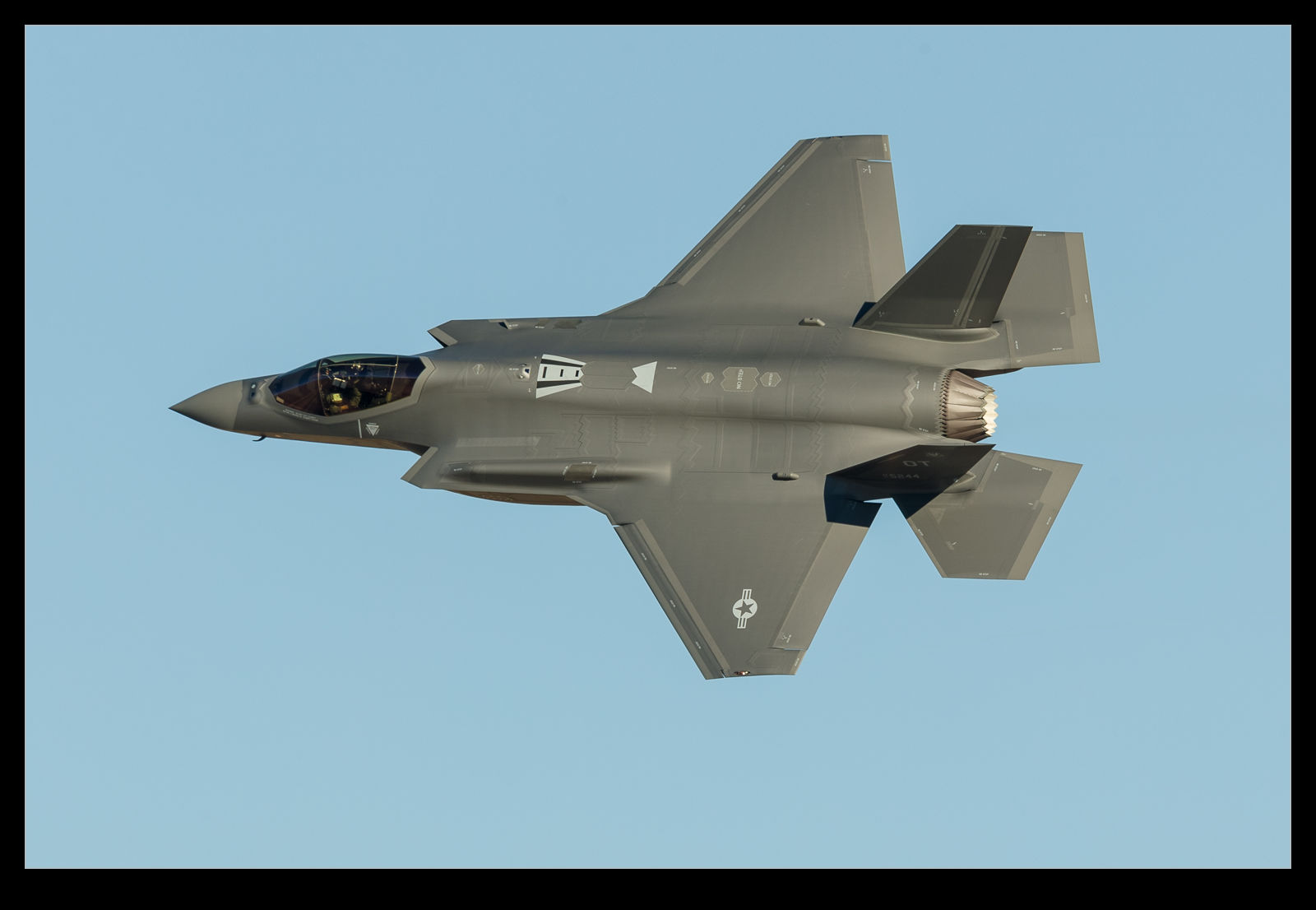 The evening light combined with the great angles made for some good shots. It didn’t hurt that I had a lower shutter speed than usual so got some nice blur of the mountains behind the planes courtesy of them being nice and low. The Strike Eagles also gave it a go which was nice.
The evening light combined with the great angles made for some good shots. It didn’t hurt that I had a lower shutter speed than usual so got some nice blur of the mountains behind the planes courtesy of them being nice and low. The Strike Eagles also gave it a go which was nice.
- A USAF Lockheed Martin F-35 Lightning II flexes on departure from Nellis AFB NV.
E-8C JSTARS
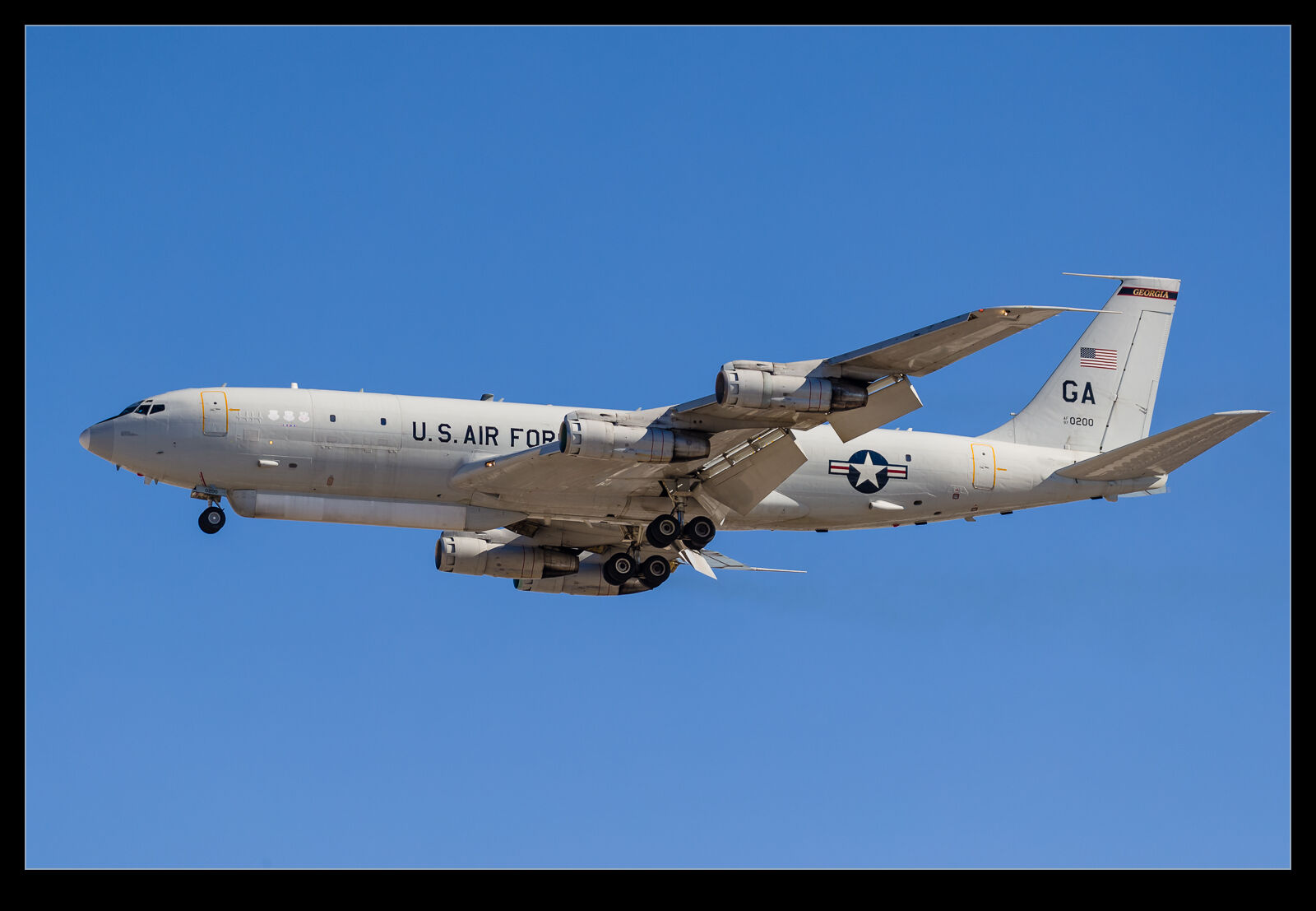 E-8 JSTARS are not a rare thing at Red Flag but they do often get involved in the night sorties. Seeing one heading out to play for the daytime activities was a pleasant surprise. On their return on the first day they were following in the KDC-10 that I mentioned in a previous post. They also adopted some sporty approach techniques and were similarly unsuccessful in converting them in to a landing. The go around ensued and was followed by a more conventional straight in approach and landing.
E-8 JSTARS are not a rare thing at Red Flag but they do often get involved in the night sorties. Seeing one heading out to play for the daytime activities was a pleasant surprise. On their return on the first day they were following in the KDC-10 that I mentioned in a previous post. They also adopted some sporty approach techniques and were similarly unsuccessful in converting them in to a landing. The go around ensued and was followed by a more conventional straight in approach and landing.
Please Come Back Before Sunset
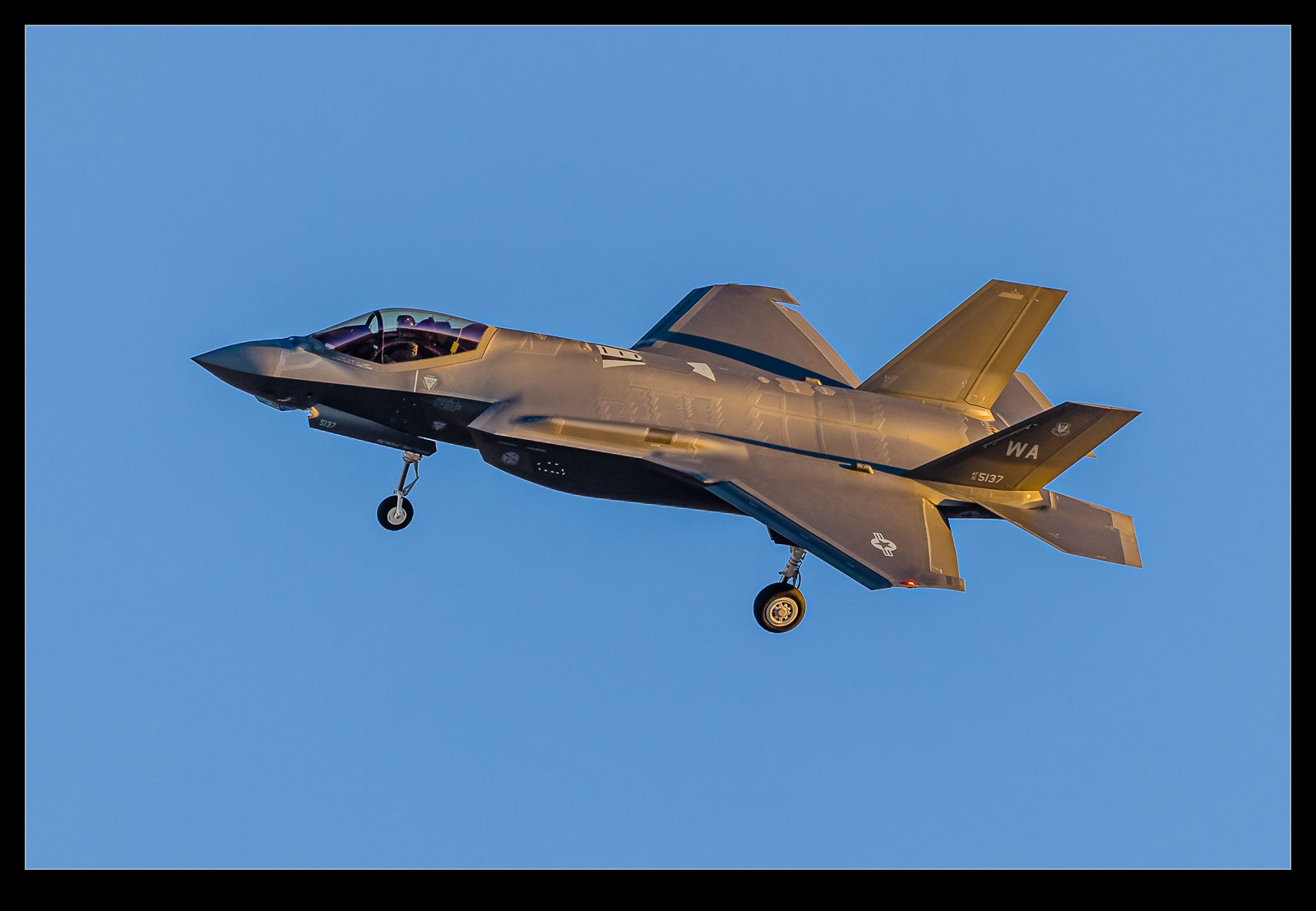 Some late day departures after the Flag returns included F-15Es, F-35As, L159s and A-4s. You don’t know how long anyone is scheduled to be out but you find yourself hoping that they will all make it back before the sun sets so you can get some arrival shots in the nicest light available. Once they are gone, it is a case of watching the time and crossing your fingers. As it was, we got lucky. They came back in a steady stream with all of them showing up as the sun was at its best. Arriving over Cheyenne is not ideal from a sun angle perspective at this time of year but we still got some nice angles. Some turned tighter while others went wider so we got to try all sorts of angles out to see which picked up what light was remaining.
Some late day departures after the Flag returns included F-15Es, F-35As, L159s and A-4s. You don’t know how long anyone is scheduled to be out but you find yourself hoping that they will all make it back before the sun sets so you can get some arrival shots in the nicest light available. Once they are gone, it is a case of watching the time and crossing your fingers. As it was, we got lucky. They came back in a steady stream with all of them showing up as the sun was at its best. Arriving over Cheyenne is not ideal from a sun angle perspective at this time of year but we still got some nice angles. Some turned tighter while others went wider so we got to try all sorts of angles out to see which picked up what light was remaining.
- A USAF Lockheed Martin F-35A Lightning II turns on to final approach at Nellis AFB NV.
- Two USAF Lockheed Martin F-35A Lightning IIs run in to the break for landing at Nellis AFB NV.
- A USAF Boeing F-15E Strike Eagles turns on to final approach at Nellis AFB NV.
Medusa Flight for the First Delivery
 Finally, the first Boeing KC-46 Pegasus tankers were delivered to the USAF. Not one but two tankers were delivered in the ceremony, a nice effort at a joke by Boeing having left everyone thinking it would only be one. Then again, when you have that many of them sitting around, I guess it should have been even more! The ceremony took place on one day and the delivery was the following morning.
Finally, the first Boeing KC-46 Pegasus tankers were delivered to the USAF. Not one but two tankers were delivered in the ceremony, a nice effort at a joke by Boeing having left everyone thinking it would only be one. Then again, when you have that many of them sitting around, I guess it should have been even more! The ceremony took place on one day and the delivery was the following morning.
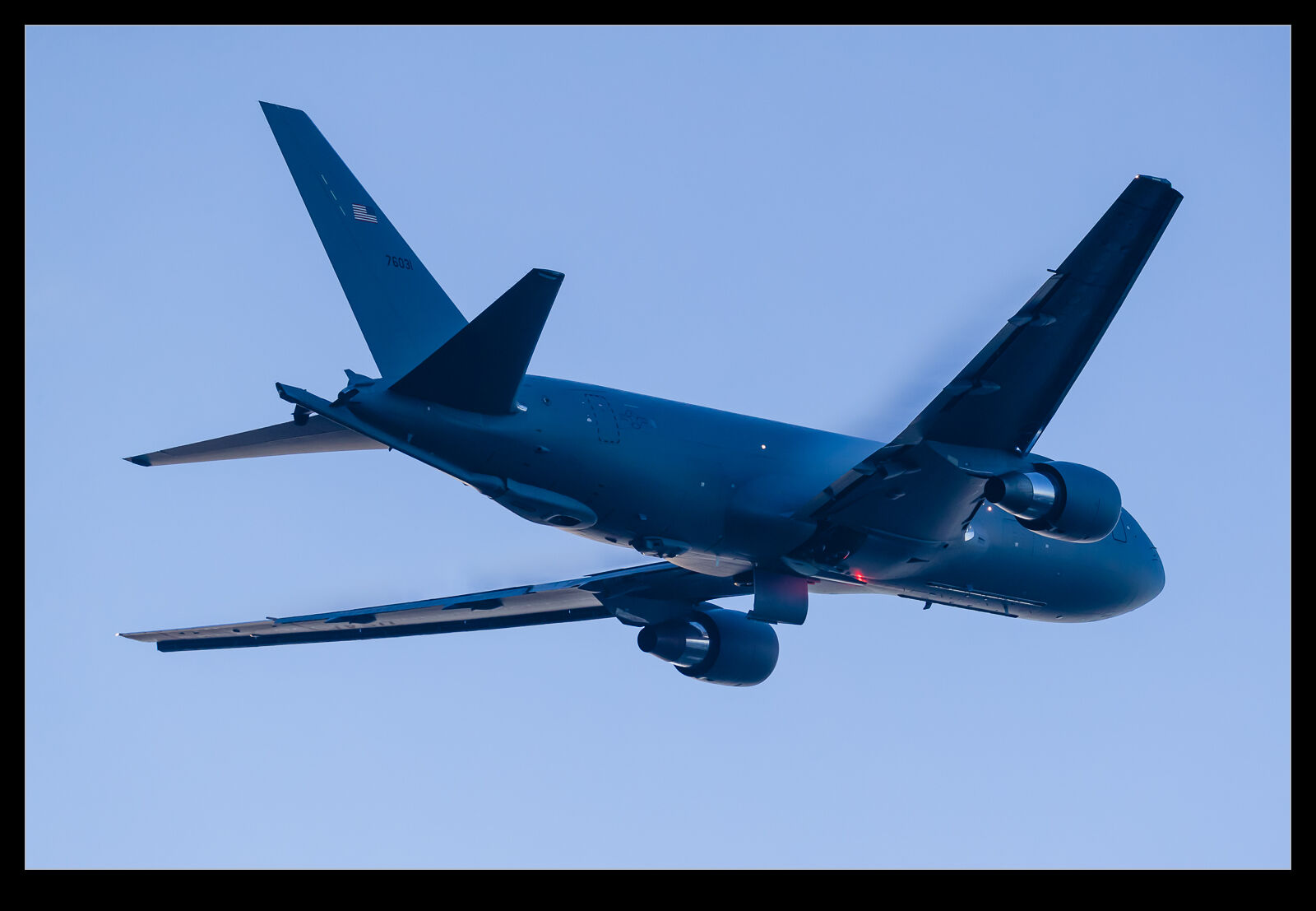 The jets left from Paine Field just after sunrise. That is sunrise if you don’t have clouds on the horizon. The sun had barely squeaked above those when the two jets took off as Medusa 1 and 2. They were preceded by a McConnell AFB KC-135R – the aircraft that they will be replacing. It got airborne in very limited light and headed for Kansas. Then the two new jets lined up in turn and departed. No flybys or wing waggles. Just gear up, switch to departure frequency and off into the steadily brightening sky. Avoid the traffic inbound to SeaTac and off you go. Lots more should be following soon while efforts continue to fix the issues with the camera system and the underwing hose and drogue pods.
The jets left from Paine Field just after sunrise. That is sunrise if you don’t have clouds on the horizon. The sun had barely squeaked above those when the two jets took off as Medusa 1 and 2. They were preceded by a McConnell AFB KC-135R – the aircraft that they will be replacing. It got airborne in very limited light and headed for Kansas. Then the two new jets lined up in turn and departed. No flybys or wing waggles. Just gear up, switch to departure frequency and off into the steadily brightening sky. Avoid the traffic inbound to SeaTac and off you go. Lots more should be following soon while efforts continue to fix the issues with the camera system and the underwing hose and drogue pods.
Details of a Pegasus
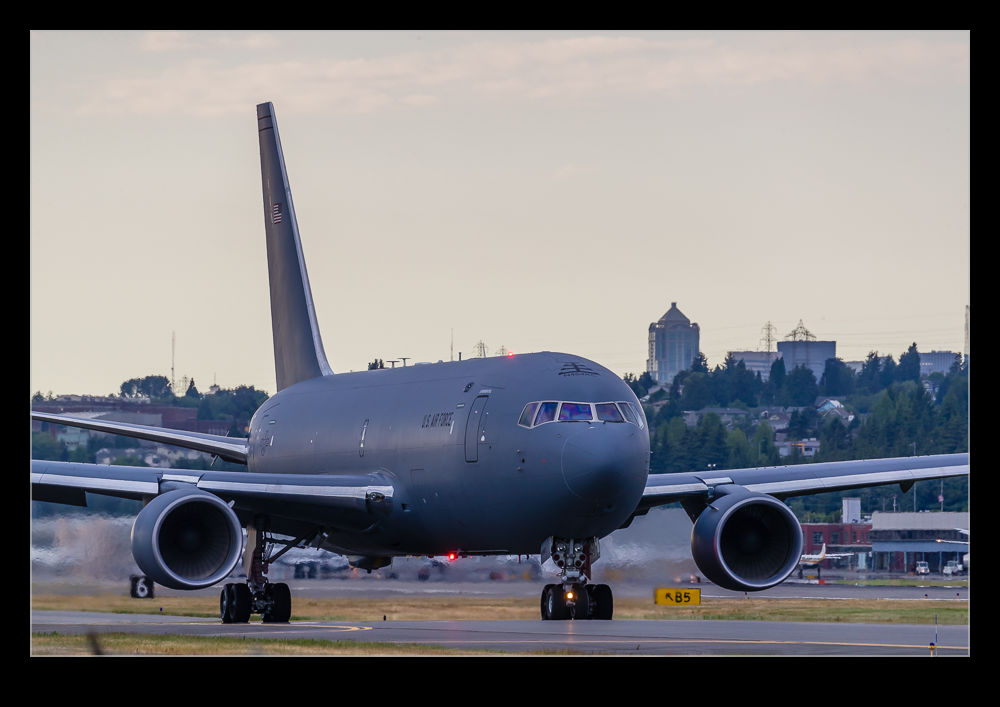 The KC-46 Pegasus test program drags on. The delivery of jets to the USAF is still not happening and the number of jets built increases but they are stacking up at Paine Field and Boeing Field. Meanwhile the test jets are working through test points and endeavoring to prove that the problems identified in previous tests are now resolved. I have seen a few jets now and shot them in varying conditions from sun to downpours.
The KC-46 Pegasus test program drags on. The delivery of jets to the USAF is still not happening and the number of jets built increases but they are stacking up at Paine Field and Boeing Field. Meanwhile the test jets are working through test points and endeavoring to prove that the problems identified in previous tests are now resolved. I have seen a few jets now and shot them in varying conditions from sun to downpours.
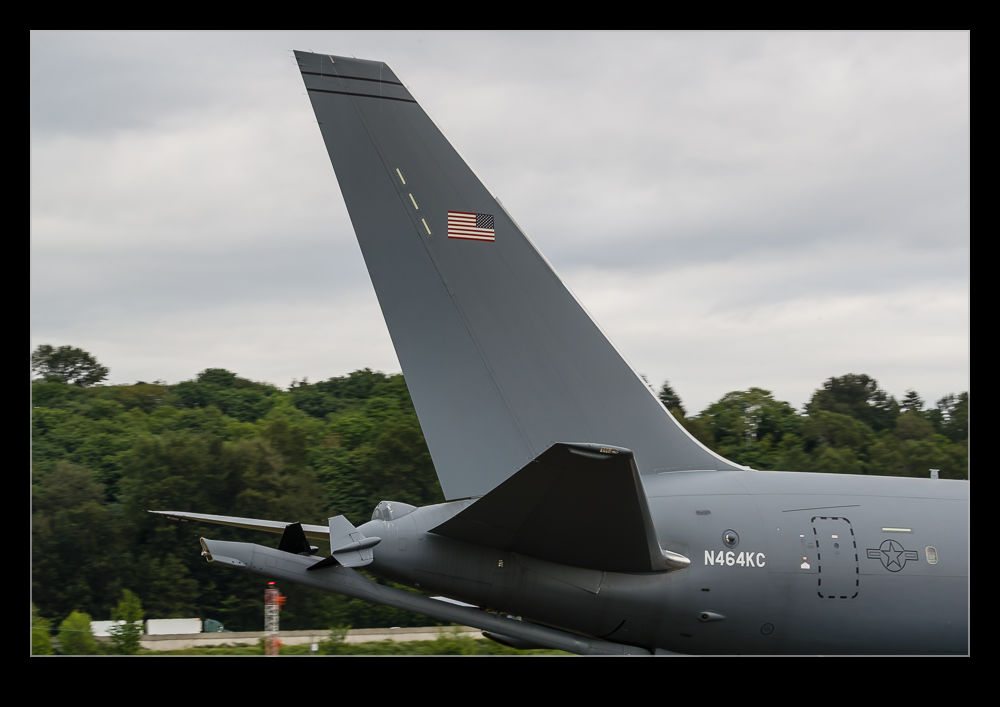 I was at Boeing Field one evening waiting to pick up someone at SeaTac later in the evening when one of the test jets taxied out from the Boeing ramp at the north of the field and came right by me prior to departing on another mission. The jet was configured with the boom and the underwing pods so the planned final configuration. As it came by, I decided to get some shots of the airframe to get a better idea of what the various parts look like.
I was at Boeing Field one evening waiting to pick up someone at SeaTac later in the evening when one of the test jets taxied out from the Boeing ramp at the north of the field and came right by me prior to departing on another mission. The jet was configured with the boom and the underwing pods so the planned final configuration. As it came by, I decided to get some shots of the airframe to get a better idea of what the various parts look like.
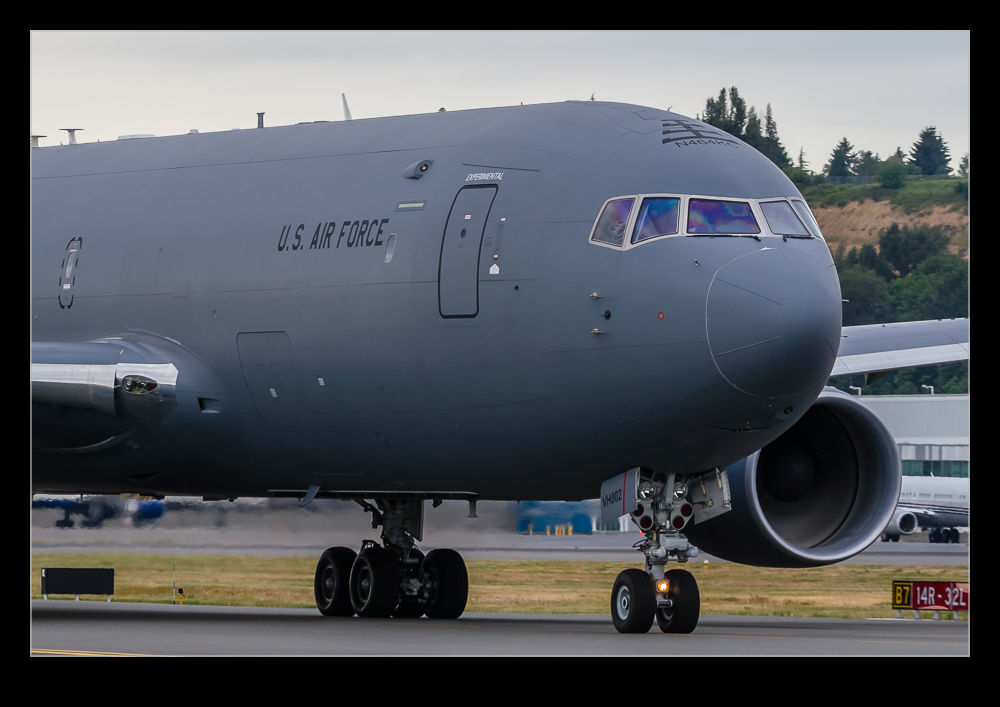 The airframe is the familiar 767 although there are some changes structurally. The cockpit is updated too but you can’t see that from the outside. However, you can see the various sensors mounted around the airframe which, I assume, are radar detectors. Above the cockpit is the receiver receptacle for the refueling boom to allow the jet to receive as well as dispense fuel. You can’t see much from the ground other than the markings to guide the boomer (and the markings that identify which jet it is).
The airframe is the familiar 767 although there are some changes structurally. The cockpit is updated too but you can’t see that from the outside. However, you can see the various sensors mounted around the airframe which, I assume, are radar detectors. Above the cockpit is the receiver receptacle for the refueling boom to allow the jet to receive as well as dispense fuel. You can’t see much from the ground other than the markings to guide the boomer (and the markings that identify which jet it is).
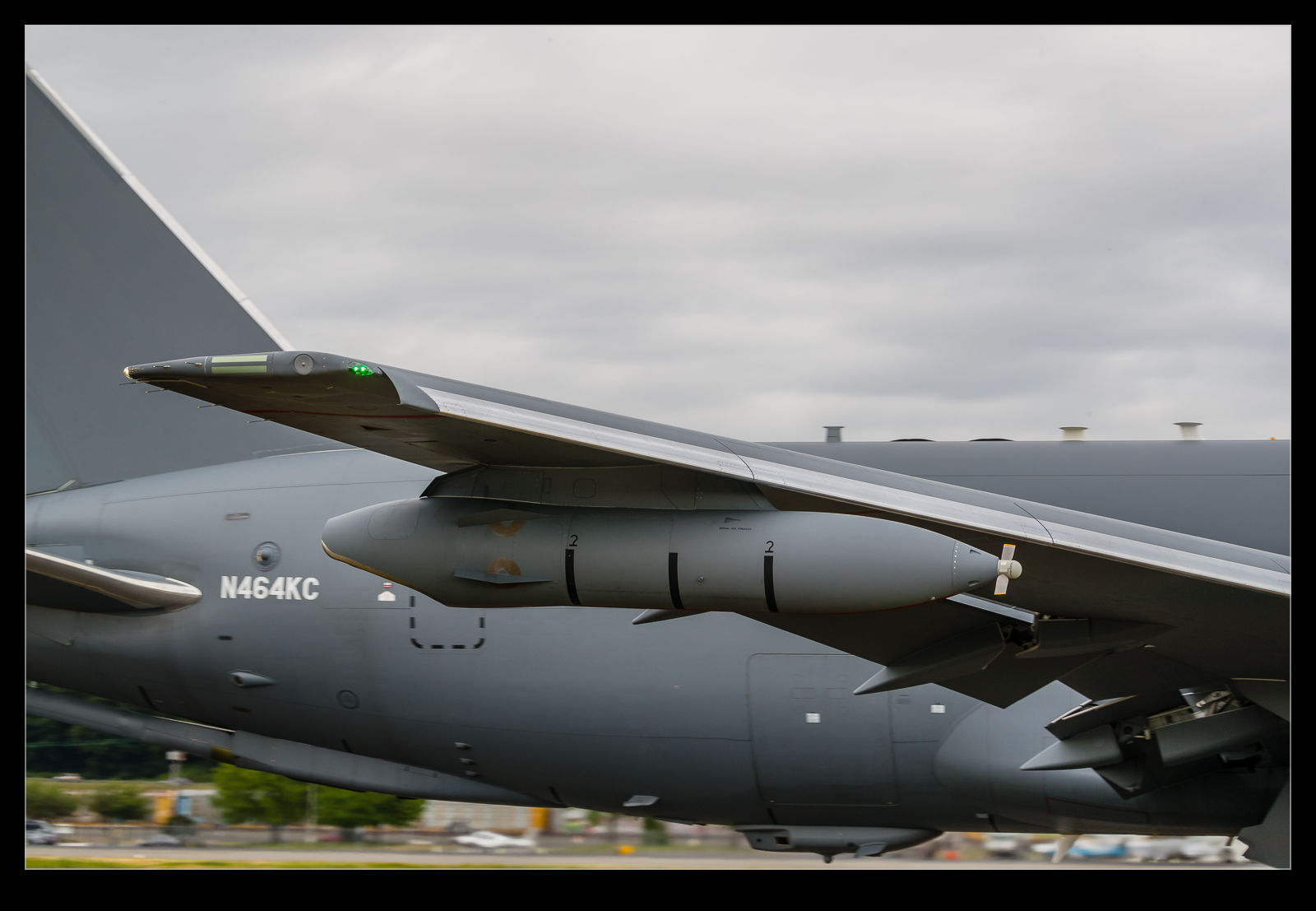 The underwing refueling pods are a source of some of the troubles the program is having. Apparently, the supplier in the UK underestimated what was required to achieve he civil certification that is part of the contract requirements. The pods may not be cleared when the initial jets finally enter service. Modern pods have a more streamlined look. Earlier pods have a blunt back end that the hose and drought come out of. The modern pods and more streamlined and the rogue comes out of a ramp in the bottom of the pod.
The underwing refueling pods are a source of some of the troubles the program is having. Apparently, the supplier in the UK underestimated what was required to achieve he civil certification that is part of the contract requirements. The pods may not be cleared when the initial jets finally enter service. Modern pods have a more streamlined look. Earlier pods have a blunt back end that the hose and drought come out of. The modern pods and more streamlined and the rogue comes out of a ramp in the bottom of the pod.
The back end has the boom. Given how many boom tankers Boeing has produced, modern booms seem to cause them a lot of trouble. This one is still one of the major defects with the jet. Hopefully it will be resolved soon. The boomer does not have a window like the earlier jets but instead uses stereo video cameras to give the boomer the view of what is going on. I assume some of the apertures around the rear fuselage are for the cameras to support this functionality. We shall see how long it is before we see this being used for real by the USAF as opposed to the test team.
Forgotten F-22 Pass
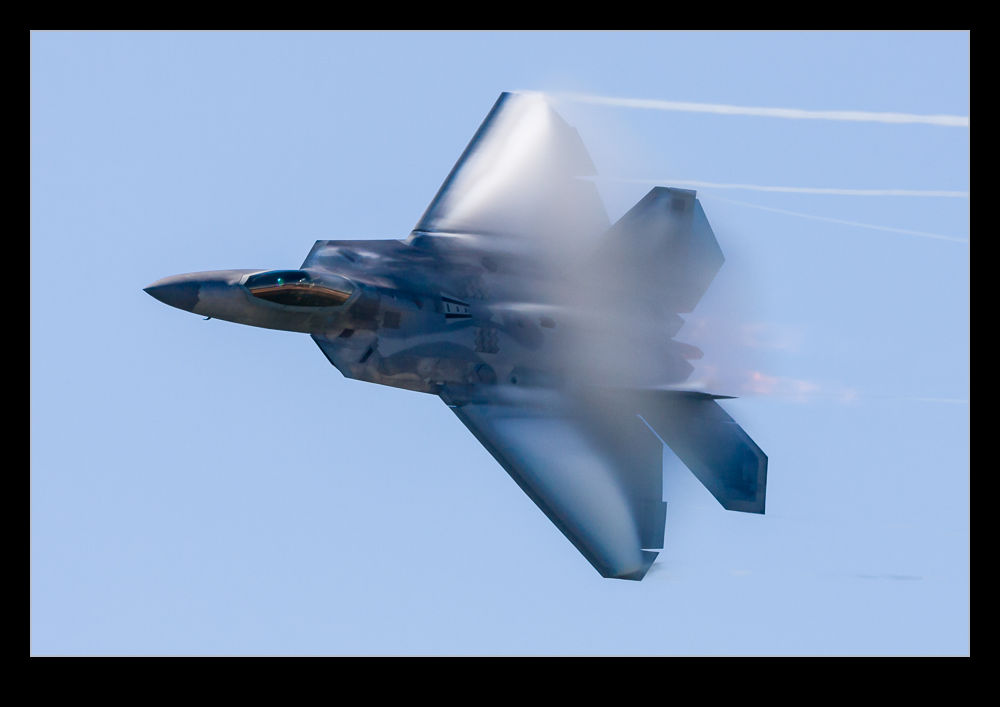 There are a lot of air shows that I have been to over the years. You think you remember them well and then something shows up in your archive of images that you have completely forgotten about. I am a member of a Facebook group that has a different challenge each week and, when I get the next challenge, I work through my catalog to see what I have that might contribute. It is an interesting exercise in finding stuff that I had forgotten about.
There are a lot of air shows that I have been to over the years. You think you remember them well and then something shows up in your archive of images that you have completely forgotten about. I am a member of a Facebook group that has a different challenge each week and, when I get the next challenge, I work through my catalog to see what I have that might contribute. It is an interesting exercise in finding stuff that I had forgotten about.
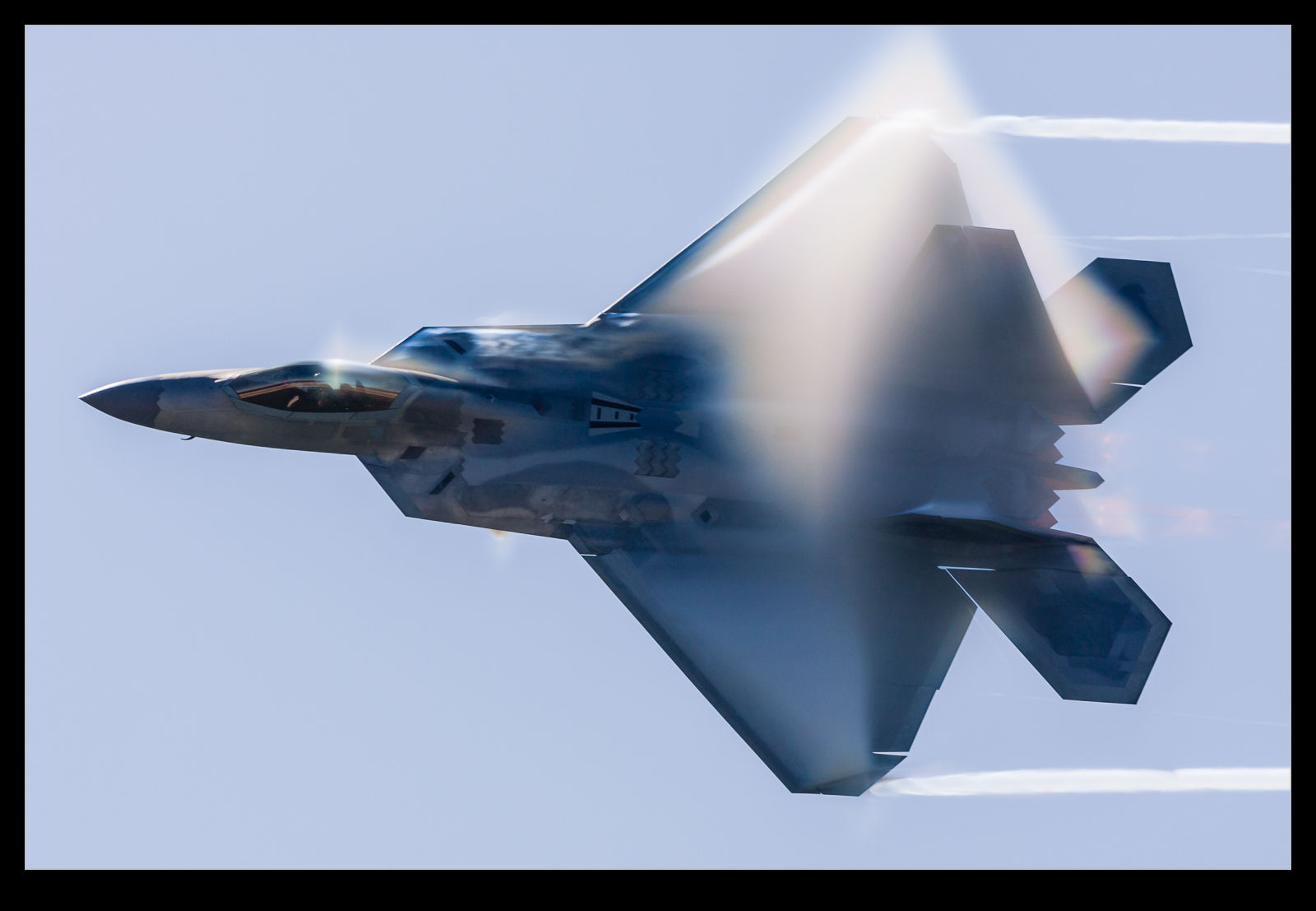 This wasn’t one of those challenges but I was looking for something else when I came across this shot of an F-22 pulling vapor and shockwaves as it did a fast pass at the Rockford Air Show. Rockford was a great show that I used to go to when I lived in Chicago. They always got great static displays and performers for the flying display. The only limitation was that you were pretty much shooting in to the sun.
This wasn’t one of those challenges but I was looking for something else when I came across this shot of an F-22 pulling vapor and shockwaves as it did a fast pass at the Rockford Air Show. Rockford was a great show that I used to go to when I lived in Chicago. They always got great static displays and performers for the flying display. The only limitation was that you were pretty much shooting in to the sun.
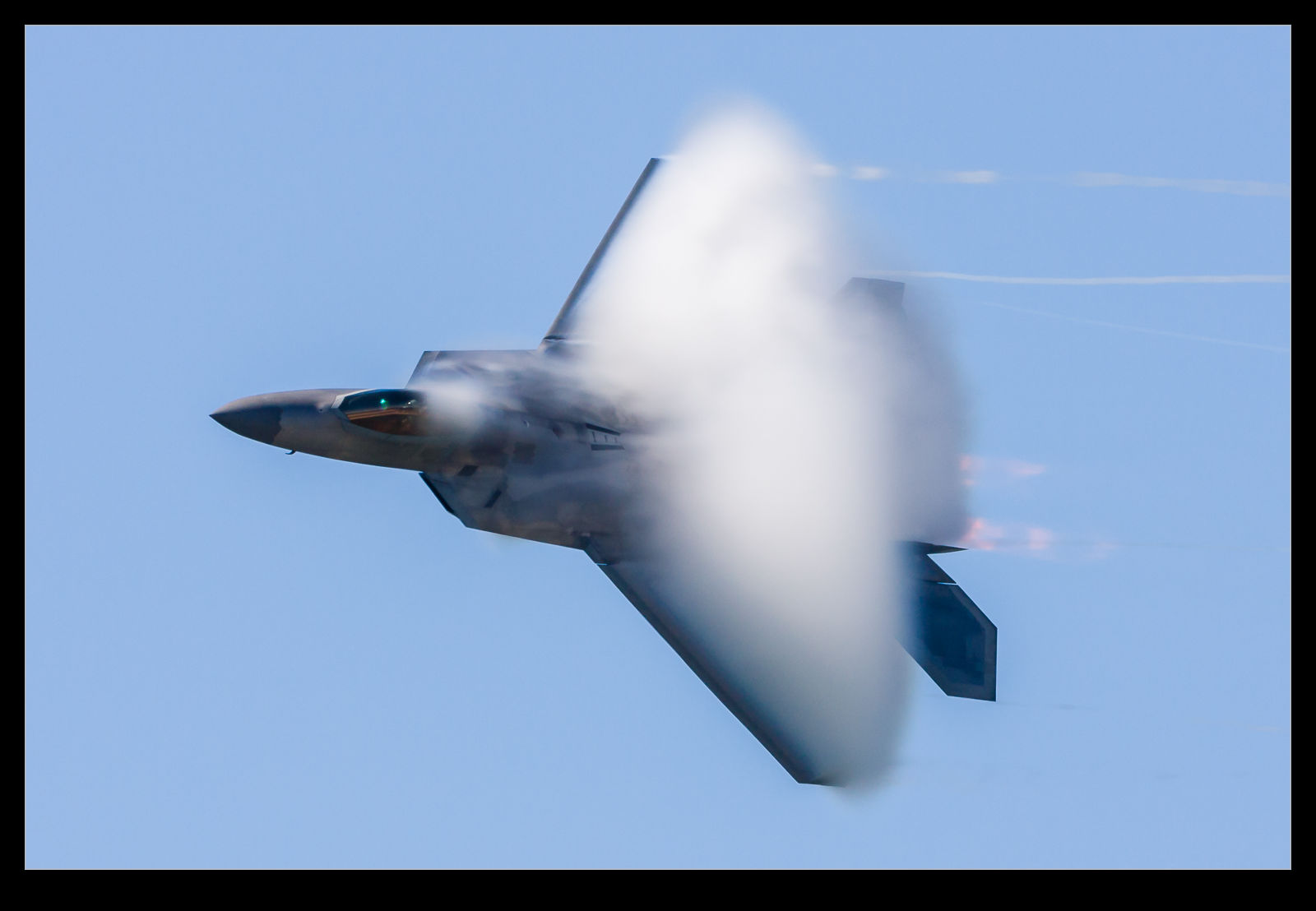 This F-22 made a fast pass and was clearly pulling a lot of vapor as it went. I don’t know why I forgot about this sequence but apparently I did. I had a go at processing them again to see what I could make of the shots this time compared to my technique in 2009. Not an easy shot to make work but the plane is dramatic enough to make it worthwhile I think.
This F-22 made a fast pass and was clearly pulling a lot of vapor as it went. I don’t know why I forgot about this sequence but apparently I did. I had a go at processing them again to see what I could make of the shots this time compared to my technique in 2009. Not an easy shot to make work but the plane is dramatic enough to make it worthwhile I think.
Sure, Wait for the Storm
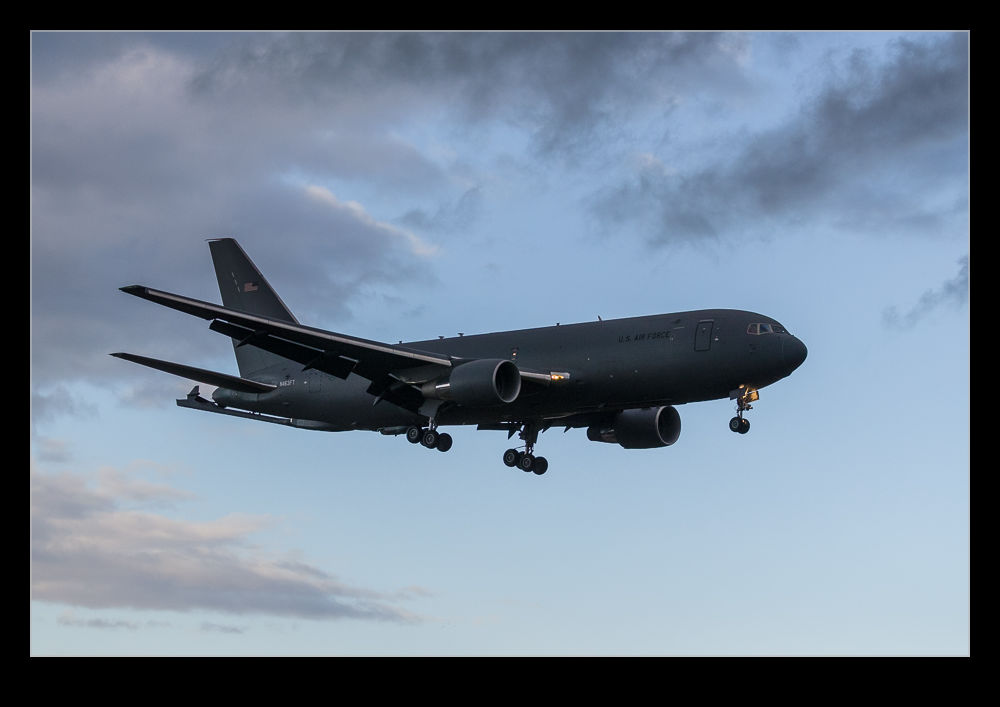 When the weather starts to turn, you can assume that whatever you are waiting for is likely to show up just after it gets bad. In this case, a KC-46 Pegasus was on its way back to Boeing Field and the clouds were rolling in. Things were getting darker and it looked like the clouds would open. Meanwhile, the KC-46 was still a distance away.
When the weather starts to turn, you can assume that whatever you are waiting for is likely to show up just after it gets bad. In this case, a KC-46 Pegasus was on its way back to Boeing Field and the clouds were rolling in. Things were getting darker and it looked like the clouds would open. Meanwhile, the KC-46 was still a distance away.
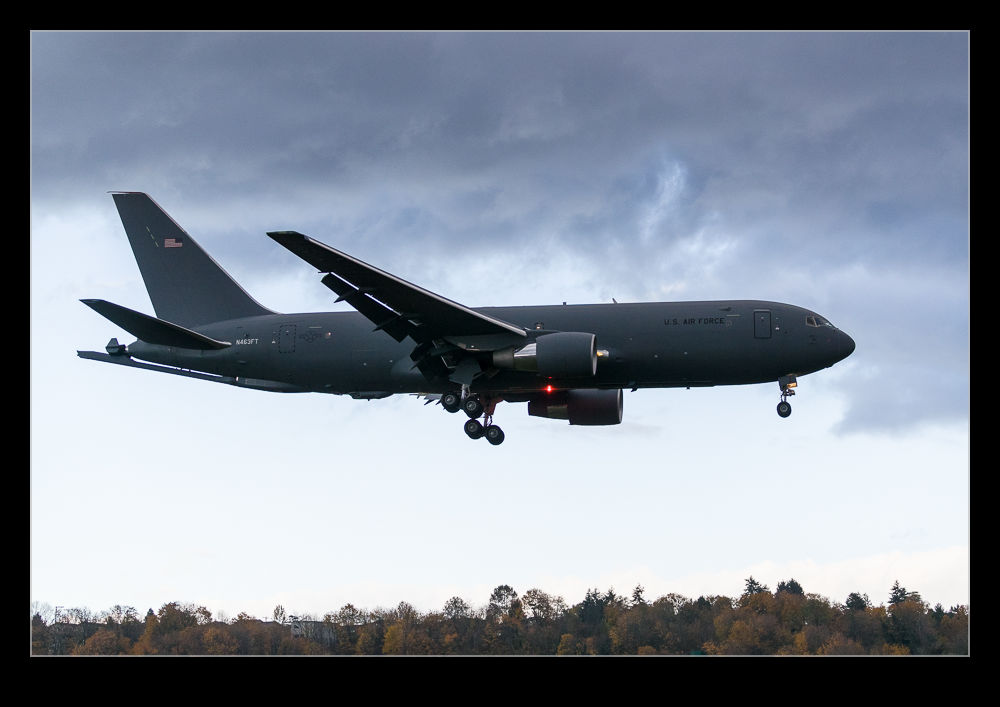 Sure enough, the skies opened. By the time the jet was on final approach, the light had disappeared and the rain was belting down. I got some shots of it but, even with a bunch of exposure compensation, the jet was more of a silhouette than anything else. A little post processing help brought out the detail but this was not an ideal shooting situation. A dark grey jet in dying light is just what you want!
Sure enough, the skies opened. By the time the jet was on final approach, the light had disappeared and the rain was belting down. I got some shots of it but, even with a bunch of exposure compensation, the jet was more of a silhouette than anything else. A little post processing help brought out the detail but this was not an ideal shooting situation. A dark grey jet in dying light is just what you want!

